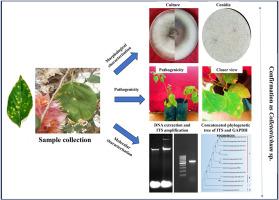印度九重葛(Bougainvillea spectabilis Willd.)引起叶斑病的炭疽菌gloeosporioides首次报道
IF 3.3
3区 农林科学
Q2 PLANT SCIENCES
引用次数: 0
摘要
三角梅(Bougainvillea spectabilis wild .)是一种广泛种植的观赏植物,因其充满活力的苞片和弹性而受到越来越多的叶面疾病的威胁,这些疾病损害了它的美学和生理功能。本文报道了印度卡纳塔克邦三角梅叶斑病伴生炭疽菌的发病情况。2024年4月,从观赏花园收集的症状叶片表现为水浸病变进展为坏死斑点,并伴有褪绿晕,主要影响老叶。在农业科学大学、GKVK、班加罗尔和卡纳塔克邦的其他调查地点,症状性叶病指数约为20.50至41.00。在PDA上的病原菌分离发现菌落具有棉质到蓬松的特征,菌丝生长呈白色。分生孢子呈圆柱形,透明,无孢子,平均分生孢子大小为15.29 × 4.27 μm。培养和形态鉴定表明与炭疽菌属的关联是该病的病因。内部转录间隔区(ITS)、甘油醛-3-磷酸脱氢酶(GAPDH)和几丁质合成酶1 (CHS1)基因的靶向多位点测序证实了该病原菌为gloeosporioides。最大似然法的系统发育分析进一步支持了这一结论。致病性分析符合科赫的假设,接种的植物表现出与在田间条件下观察到的相同的自然症状。证实了C. gloeosporioides的存在,突出了它在印度亚热带条件下作为三角梅叶面病原体的新兴作用。本文章由计算机程序翻译,如有差异,请以英文原文为准。

First report of Colletotrichum gloeosporioides causing leaf spot in Bougainvillea (Bougainvillea spectabilis Willd.) in India
Bougainvillea (Bougainvillea spectabilis Willd.), a widely cultivated ornamental plant valued for its vibrant bracts and resilience, is increasingly threatened by foliar diseases that compromise its aesthetic and physiological functions. This study reports the incidence of Colletotrichum gloeosporioides associated with leaf spot disease on Bougainvillea in Karnataka, India. In April 2024, symptomatic leaves manifested as water-soaked lesions progressing into necrotic spots with chlorotic halos, primarily affecting older foliage, were collected from ornamental gardens. The symptomatic leaf disease index ranged from approximately 20.50 to 41.00 at the University of Agricultural Sciences, GKVK, Bangalore, and other surveyed locations in Karnataka. Pathogen isolation on PDA revealed colonies with characteristic cottony to fluffy, whitish mycelial growth. The conidia were cylindrical, hyaline, and aseptate, with an average conidial size of 15.29 × 4.27 μm. Cultural and morphological characterization revealed that the association with Colletotrichum spp. is the cause of the disease. The targeted multilocus sequencing of the internal transcribed spacer (ITS) region, glyceraldehyde-3-phosphate dehydrogenase (GAPDH) and chitin synthase 1 (CHS1) gene confirmed the identity of the pathogen as C. gloeosporioides. Phylogenetic analysis using Maximum Likelihood method further supported this identification. Pathogenicity assays fulfilled Koch's postulates, with inoculated plants exhibiting the same natural symptoms as those observed in the field conditions. The confirmed presence of C. gloeosporioides highlights its emerging role as a foliar pathogen in Bougainvillea under subtropical conditions in India.
求助全文
通过发布文献求助,成功后即可免费获取论文全文。
去求助
来源期刊
CiteScore
4.30
自引率
7.40%
发文量
130
审稿时长
38 days
期刊介绍:
Physiological and Molecular Plant Pathology provides an International forum for original research papers, reviews, and commentaries on all aspects of the molecular biology, biochemistry, physiology, histology and cytology, genetics and evolution of plant-microbe interactions.
Papers on all kinds of infective pathogen, including viruses, prokaryotes, fungi, and nematodes, as well as mutualistic organisms such as Rhizobium and mycorrhyzal fungi, are acceptable as long as they have a bearing on the interaction between pathogen and plant.

 求助内容:
求助内容: 应助结果提醒方式:
应助结果提醒方式:


